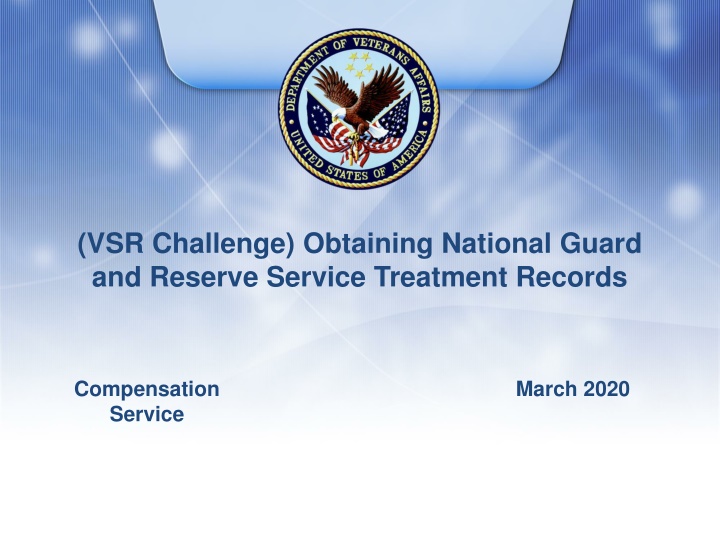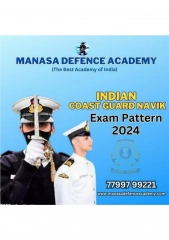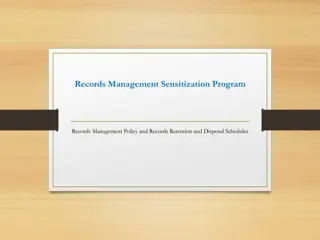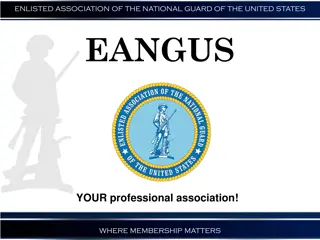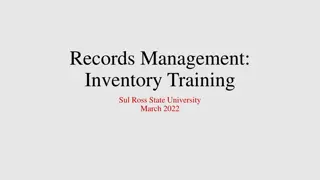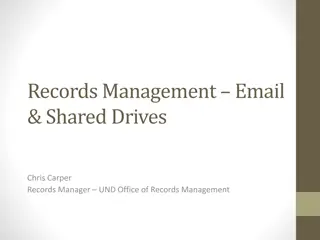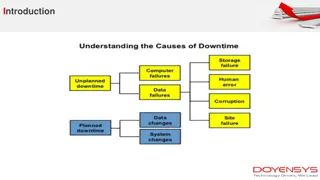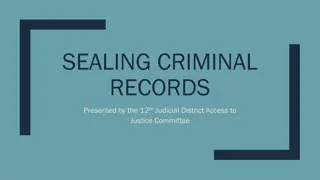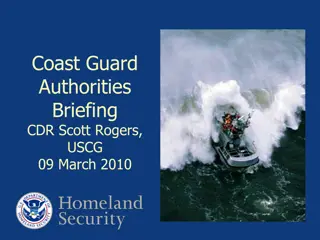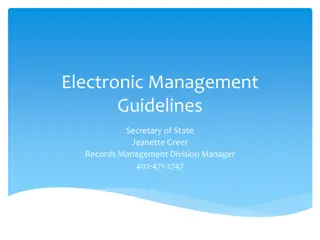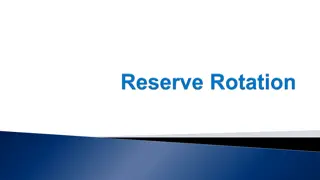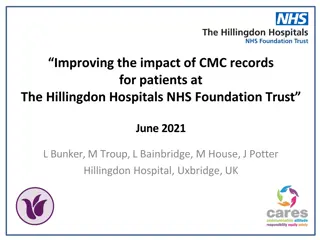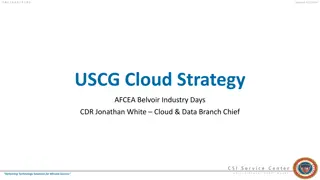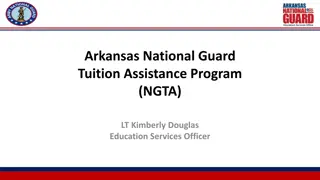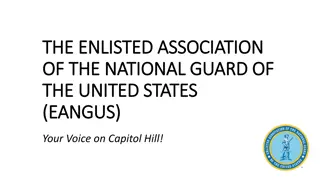National Guard and Reserve Service Records Overview
This training covers types of military service eligible for compensation, variables affecting treatment records development, and procedures for obtaining records for National Guard and Reserve members. Learn about duty periods, definitions, and eligibility criteria.
Download Presentation

Please find below an Image/Link to download the presentation.
The content on the website is provided AS IS for your information and personal use only. It may not be sold, licensed, or shared on other websites without obtaining consent from the author.If you encounter any issues during the download, it is possible that the publisher has removed the file from their server.
You are allowed to download the files provided on this website for personal or commercial use, subject to the condition that they are used lawfully. All files are the property of their respective owners.
The content on the website is provided AS IS for your information and personal use only. It may not be sold, licensed, or shared on other websites without obtaining consent from the author.
E N D
Presentation Transcript
(VSR Challenge) Obtaining National Guard and Reserve Service Treatment Records Compensation Service March 2020
Objectives After this training, the trainee will be able to: List the different types of military service that are eligible for service-connection (active military, naval, or air service) Articulate the variables that affect development for service treatment records (STRs) for members of the National Guard and Reserve Understand STRs development for members of the National Guard and Reserve 2
References CFR 3.1 (d) Definition of a Veteran CFR 3.6 Duty Periods M21-1, Part III, Subpart iii, Chapter 2, Section B, 2 Migration of STRs M21-1, Part III, Subpart iii, Chapter 2, Section B, 3 Procedures for Obtaining STRs 3
Definitions A Veteran means any person who served in the active military, naval, or air service and who discharged or released under conditions other than dishonorable. Duty Periods: Active military, naval, or air service can be a period of: active duty military service active duty for training during which the individual was disabled/died by an injury or developed a disease incurred or aggravated by service inactive duty for training during which the individual was disabled/died by an injury incurred or aggravated by service 4
Duty Periods Active Duty Active Duty Full-time duty in the Armed Forces Full-time duty as a commissioned officer of the Public Health Service (PHS) Full-time duty as a commissioned officer of the Coast and Geodetic Survey, the Environmental Science Services Administration, and the National Oceanic and Atmospheric Administration Service as a cadet or midshipman at a service academy Attendance at the preparatory schools of the service academies for enlisted active-duty members Authorized travel to and from such duty 38 CFR 3.6 Duty Periods 5
Duty Periods Active Duty for Training Active Duty for Training (ADT) Veterans that served during a period of active duty for training are eligible for service-connection for injuries or diseases that were incurred or aggravated in the line-of-duty. 6
Duty Periods Active Duty for Training Active Duty for Training (ADT) Full-time duty in the Armed Forces performed by Reserves for training Full-time duty as a commissioned officer of the Reserve Corps of PHS for training Full-time duty performed by members of the National Guard under 32 U.S.C. Duty performed by a member of the Senior Reserve Officers Training Corps (ROTC) program Attendance at the preparatory schools of the service academies for all other individuals Authorized travel to and from such duty 7
Duty Periods Inactive Duty for Training Inactive Duty for Training Veterans that served during a period of inactive duty for training are eligible for service-connection for injuries that were incurred in the line-of-duty.** **The Veteran is also eligible if an acute myocardial infarction, a cardiac arrest, or a cerebrovascular accident occurs during a period of inactive duty or training.** 8
Duty Periods Inactive Duty for Training Inactive Duty for Training Duty (other than full-time) prescribed for Reserves (includes officers of the PHS) Special additional duties authorized for Reserves (includes officers of the PHS) Training (other than ADT) by a member of the Senior ROTC Duty performed by a member of the Senior Reserve Officers Training Corps (ROTC) program Duty (other than full-time) performed by a member of the National Guard under 32 U.S.C. Authorized travel to and from such duty 9
Variables Affecting Development Service Obligation vs. Discharge Reserves/National Guard Individual Ready Reserves (IRR) Complete Discharge Date of Discharge Branch of Service Claimed Conditions 10
Service Obligation vs. Discharge Veterans Information Solution (VIS) SA: currently active in National Guard or Reserves RE: currently Inactive National Guard (ING) or Individual Ready Reserve (IRR) 11
Service Obligation vs. Discharge DD Form 214, Certificate of Release or Discharge From Active Duty Release from Active Duty: additional obligation Discharge: no further obligation 12
Check for Comprehension Did the Veteran ever serve in the Reserves or National Guard? Does the Veteran have a service obligation? 13
Check for Comprehension Did the Veteran ever serve in the Reserves or National Guard? Yes; Reserves Does the Veteran have a service obligation? No 14
Army **STRs were previously held at Records Management Center (RMC). These STRs are currently in the process of being scanned and uploaded to Veterans Benefits Management System (VBMS). For more information see Source Material Tracking System (SMTS) see M21-1 III.ii.1.F.5.a and III.iii.2.A.4.a** 15
Navy **STRs were previously held at RMC. These STRs are currently in the process of being scanned and uploaded to VBMS. For more information see SMTS see M21-1 III.ii.1.F.5.a and III.iii.2.A.4.a** 16
Air Force **STRs were previously held at RMC. These STRs are currently in the process of being scanned and uploaded to VBMS. For more information see SMTS see M21-1 III.ii.1.F.5.a and III.iii.2.A.4.a** 17
Marine Corps **STRs were previously held at RMC. These STRs are currently in the process of being scanned and uploaded to VBMS. For more information see SMTS see M21-1 III.ii.1.F.5.a and III.iii.2.A.4.a** 18
Coast Guard **STRs were previously held at RMC. These STRs are currently in the process of being scanned and uploaded to VBMS. For more information see SMTS see M21-1 III.ii.1.F.5.a and III.iii.2.A.4.a** 19
Migration of STRs After Service Ends Exception for Army, Air Force, Navy, Marine Corps, and Coast Guard: The STRs of a number of Veterans separating or retiring from active service between September 1, 2013, and December 31, 2013, may not have been sent to RMC and instead digitized and uploaded into Department of Defense (DoD s) Healthcare Artifacts and Images Management Solution (HAIMS). Specific procedures for obtaining these transition records can be found in M21-1, Part III, Subpart iii, 2.B.3.l. Also note: The Public Health Service (PHS), and National Oceanic and Atmospheric Administration (NOAA) do not scan STRs and upload them into HAIMS. 20
STR Development Process If the Veteran DOES NOT have a service obligation, refer to the previous slides and develop based on when the Veteran was discharged. If the Veteran s service obligation HAS EXPIRED: if it occurred before January 1, 2014 (all DoD service branches) or September 1, 2014 (Coast Guard), refer to the previous slides and develop based on when the Veteran was completely discharged if it occurred after those dates, ensure that a HAIMS request has been submitted through VBMS** **If there is not a valid period of service to allow for a HAIMS request, create a temporary period of service in Participant Profile** 21
STR Development Process If the HAIMS request has been pending for over 45 days, send an email to VAVBASTL/RMC/NGRESERVES.** If the HAIMS request is UNSUCCESSFUL: review JLV for any available service records and upload them to the claims folder. if all attempts to this point have been unsuccessful, submit a PIES NG1/RV1 request. 22
STR Certificate of Completeness Starting January 1, 2013, all the service departments began to issue a certificate of completeness.** We cannot continue processing the claim without a certificate for Veterans who were discharged after January 1, 2013. The MRS is responsible for all follow-ups for the certificate. Once we receive the certificate of completeness, no further development is needed for STRs from that service department unless: The claimant alleges treatment at an MTF during service and those records are not in the STRs or accessible in JLV. **The certificate is now on a DD Form 2963.** 23
STR Certificate of Completeness The table on the following page describes the procedures for processing STRs that do not include a signed: Letter of Certification (if the STRs belong to a Veteran who separated from service between January 1, and July 31, 2013) or DD Form 2963 (if the STRs belong to a Veteran who separated from service on or after August 1, 2013). 24
STR Certificate of Completeness Stage 1 Description The claims processor reviews the claims folder for the purpose of confirming the Veteran separated from service on or after January 1, 2013, and the certification letter/DD Form 2963 is missing or unsigned. If the claims processor determines the STRs should have included a signed certification letter/DD Form 2963 but did not, he/she must send an encrypted e-mail to request certification to the VAVBASTL/RMC/STRCERT mailbox. The e-mail must include the Veteran s name Social Security number (SSN) branch of service dates of service, and the claims processor s phone number fax number, and e-mail address. 2 25
STR Certificate of Completeness 3 VA s Records Management Center (RMC) responds to the e-mail by forwarding the claims processor's request to a point of contact within the Veteran s service department. 4 The Veteran s service department provides a certification letter/ DD Form 2963 to RMC. RMC forwards the certification letter/DD Form 2963 to the claims processor. 5 If RMC does not respond to the claims processor s request within 15 days, the claims processor sends a follow-up e-mail to VAVBASTL/RMC/STRCERT. The claims processor attaches the certification letter/DD Form 2963 to the STRs, or uploads it into the electronic claims folder (eFolder) (if VA is processing the associated claim in a paperless environment). uploads it into the electronic claims folder (eFolder) (if VA is processing the associated claim in a paperless environment). 6 26
Alternative Sources If you cannot obtain STRs from federal record custodians, you can utilize alternative sources in an attempt to obtain records: Veteran Military Treatment Facilities National Guard or Reserve Unit Important: Further development to the service department for the records is not required if the certification letter/DD Form 2963 indicates the STRs or sections of the STRs are absent. However, a final notification letter must be sent to the claimant notifying him/her of the absence. 27
Final Notification Letter If we have taken all necessary steps to obtain the STRs, we must follow the standard procedure for requesting records for a Federal entity, by sending a final notification letter to the Veteran. - Prepare the final notification letter using Letter Creator tool, or prepare an equivalent notice using Personal Computer Generated Letters (PCGL). Standard Procedure for Requesting Records From a Federal Entity M21-1,III.iii.1.C.1.b. 28
Lesson Review We covered the different types of military service that are eligible for service-connection (active military, naval, or air service) We reviewed the variables that affect development for service treatment records (STRs) for members of the National Guard and Reserve You should have a better understanding of STR development for members of the National Guard and Reserve 29
Questions 30
